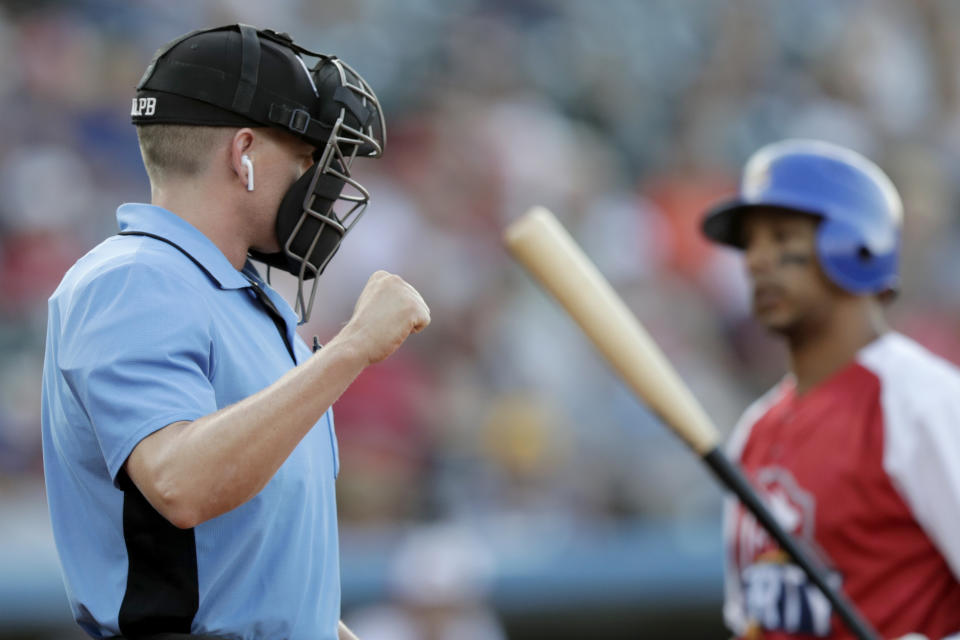'Robot umpires' debuted in the Atlantic League All-Star game, here's what happened

After much discussion, some anticipation and some disappointment, “robot umpires” have finally made its way into professional baseball.
On Wednesday, the independent Atlantic League, which is a partner of Major League Baseball, debuted the electronic strike zone during its All-Star game, making it the first American professional league to do so.
How it works:
Home plate umpire Brian deBrauwere wore an earpiece that was connected to an iPhone in his pocket. The earpiece relayed balls and strikes after receiving it from a TrackMan computer system utilizing a Doppler radar and deBrauwere called them as he received them .
Because the system is still in its infancy, an umpire is needed behind home in the event that the system fails to pick up a pitch, registers a pitch totally incorrectly or fails altogether.
As it currently stands, a ball that bounces into the zone is considered a strike and check swings are not evaluated, thus necessitating the need for umpire(s).
It should also be noted that umpires also have the ability to override the electronic call.
If you’re wondering how it looks, check it out:
Baseball history has been made. The first pitch registered by the #TrackMan automated ball-strike system is a called strike in the #AtlanticLeague All-Star game. pic.twitter.com/o8oR6RxLnr
— Rob Rose (@RobRoseSports) July 10, 2019
As you can see, there is a brief delay between when the pitch is caught and when the call is signaled.
How players and umpires reacted
The debut of the electronic strike zone was largely well received with many players having already taken note of the new changes.
"One time I already had caught the ball back from the catcher, and he signaled strike," pitcher Daryl Thompson told the AP.
Pitcher Mitch Atkins noticed that pitches higher in the strike zone were called strikes, something that is often missed.
"Technically, they're strikes, but umpires never called them," Atkins said.
Another player noted a few instances of players who struck out that were lingering because the call had not been relayed.
DeBrauwere, the umpire behind home plate, also had no issue with the change.
"This is just another plate job, and I just get a little help on this one, so I feel very relaxed going into this one," he said.
Atlantic League President Rick White said the electronic strike zone will be implemented across the Atlantic League in the time following the All-Star game.
"We're very excited about what this portends not only for our league but for the future of baseball,” White said. “What we know is technology can help umpires be more accurate, and we're committed to that. We think the Atlantic League is being a pioneer for all of the sport."
Atlantic League is testing all sorts of rule changes
The electronic strike zone is not the only change that the Atlantic League is testing. MLB will allow hitters within the Atlantic League to also steal first base.
Per the Washington Post, this is how it will work:
Any pitch on any count not caught in flight will be considered a live ball, and a batter may run to first base, similar to a dropped third strike
In addition to the electronic strike zone and stealing first base, the Atlantic League will also experiment with mounds that are further back.
Following the season, MLB will evaluate the data and determine the best way to move forward.
Still, MLB commissioner Rob Manfred has pumped the brakes on the electronic strike zone and other rule changes immediately making its way over to MLB-level games.
"We need to see how it works, first in the Atlantic League and then probably other places, meaning other parts of minor league baseball, before it comes to Major League Baseball," Manfred said. “We kind of feel it's incumbent on us to figure out whether we could make it work. And that's what we're doing."
More from Yahoo Sports:

